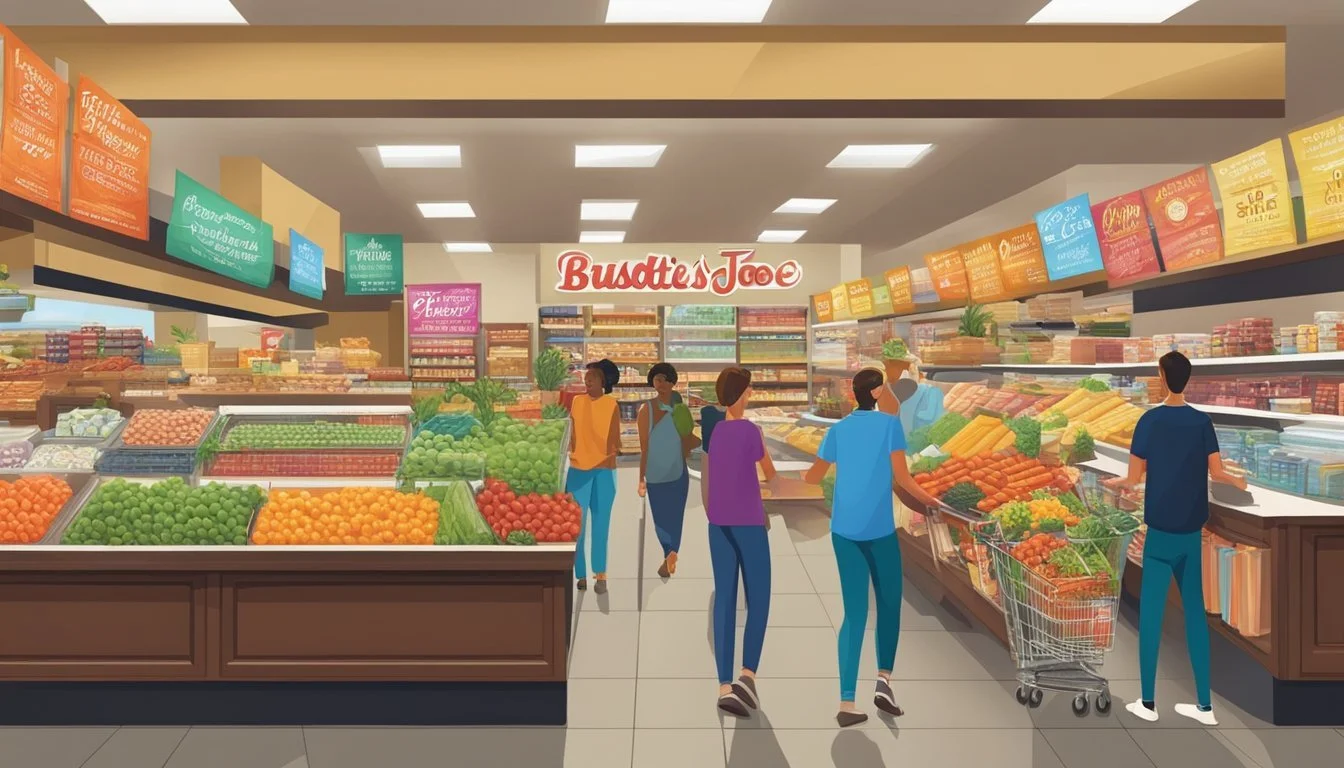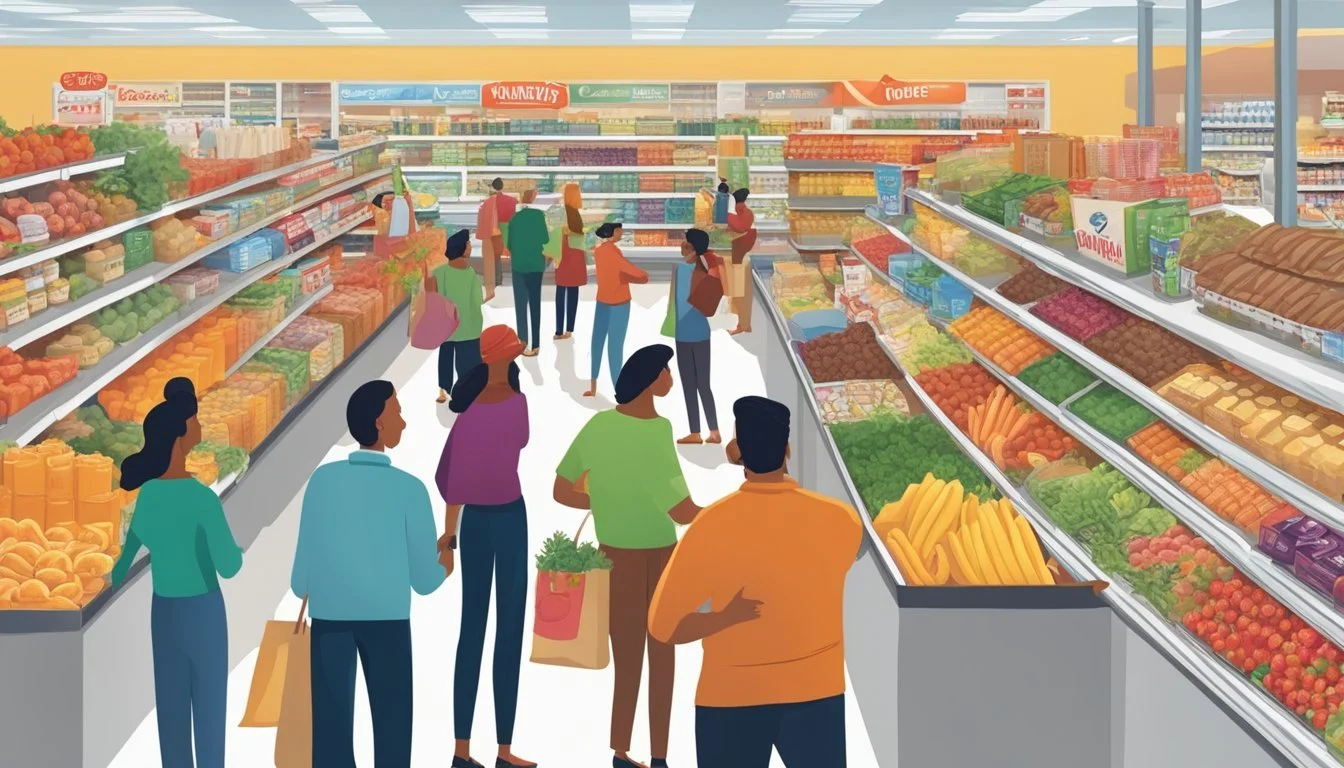Trader Joe's vs Giant Eagle
Comparing Shopping Experiences and Value
Part of Our Grocery Store Guide with Details on Trader Joe's and Giant Eagle
When considering where to shop for groceries, two names often come up in the conversation: Trader Joe's and Giant Eagle. Each supermarket chain offers a distinct shopping experience and caters to different consumer needs. Trader Joe's, known for its eclectic assortment of private-label products, has established itself as a leader in offering unique, quality items at affordable prices. With over 550 locations, Trader Joe's commitment to high-quality, natural products has made it a go-to destination for many shoppers across the United States.
Giant Eagle, on the other hand, operates primarily in the Midwest and offers a more traditional supermarket experience, with a broader range of national brands and a full-service format that includes departments like deli, bakery, and pharmacy. The store's weekly specials and loyalty programs are designed to provide value to their customers. With the rising importance of grocery savings, consumers often compare prices, product selection, and overall shopping experience between these two retailers to determine which fits their needs best.
Each grocery store has its strengths, positioning them differently in the market. Trader Joe's appeals to those seeking organic and specialty products, while Giant Eagle caters to shoppers looking for a one-stop shop with conventional brand variety. Shoppers' preferences between Trader Joe's and Giant Eagle may vary based on individual priorities such as cost, product uniqueness, shopping ambience, and store location.
Company Backgrounds
In the competitive grocery store landscape, Trader Joe's and Giant Eagle stand out with unique histories and business approaches that have shaped their growth and customer loyalty.
History of Trader Joe's
Trader Joe's started in the 1950s as a small chain of convenience stores named Pronto Market. In 1967, Joe Coulombe renamed and rebranded the stores to Trader Joe's, a nautical-themed market that targeted an educated, price-conscious customer base. They set themselves apart by eliminating the middleman, buying directly from suppliers, and passing on the savings to customers. Now, with over 550 stores, Trader Joe's is valued for its high-quality, natural products and has cultivated a loyal following.
History of Giant Eagle
Giant Eagle originated back in 1918 as a small grocery store in Pittsburgh, Pennsylvania. Through mergers and acquisitions, the company expanded and officially became Giant Eagle, Inc. in 1931. In contrast to Trader Joe's, Giant Eagle operates a larger variety of store formats, including the upscale Market District. With over 400 stores, they continue to serve a diverse customer base across several states, offering a one-stop-shop experience complete with a wide range of products and services.
Price Comparison
When shopping for groceries, price is a critical factor for many consumers. This section offers a detailed price comparison between Trader Joe's and Giant Eagle, from everyday staples to premium products and available deals.
Everyday Prices
Trader Joe's has developed a reputation for providing affordable options, often pricing their goods approximately 20% lower than competitors like Giant Eagle. On the other hand, Giant Eagle offers a range of store brands that can be competitive, but specific prices vary by location and current inventory.
Trader Joe's: Known for consistent low prices on their store brand items.
Giant Eagle: Prices can be higher, but competitive on store brands.
Discounts and Deals
Discounts and savings programs are another area to consider. While Trader Joe's does not typically offer sales or discounts, as their pricing strategy is aimed at everyday low prices, Giant Eagle provides a variety of weekly specials, coupons, and fuel perks that can lead to significant savings for shoppers who take full advantage of these deals.
Trader Joe's: No sales, but everyday low prices.
Giant Eagle: Frequent sales, plus discounts through loyalty programs.
Premium Products
For consumers interested in premium or organic products, both stores offer a selection, with Trader Joe's often being the more cost-effective option. However, it is important to compare the prices of these items as costs can fluctuate based on product type and brand.
Trader Joe's: Competitive pricing on their own premium lines.
Giant Eagle: Offers premium brands but may be more expensive than Trader Joe's.
Product Selection
When comparing Trader Joe's and Giant Eagle, shoppers will notice that each store offers a distinct range of products. Trader Joe's is recognized for its private label goods that often prioritize quality and uniqueness, while Giant Eagle provides a broad inventory that caters to various consumer needs, including a selection of both name-brand and store-brand items.
Trader Joe's Unique Offerings
Trader Joe's product selection is mainly composed of its own private-label items, which are typically curated to offer unique and globally-inspired flavors. The store takes pride in providing a selection that includes:
Organic options: A diverse assortment of organic fruits, vegetables, and grains.
Specialty items: An array of exclusive snacks, desserts, and international cuisine options.
Health-conscious products: A variety of organic, vegan, and gluten-free offerings.
Premium quality meat: Trader Joe's is known for offering high-quality meat options.
Frozen selections: A wide range of frozen meals and ingredients known for their flavor and convenience.
Giant Eagle's Inventory Range
Giant Eagle, on the other hand, boasts an extensive inventory that often includes:
Name-brand and store-brand products: Provides a choice between premium and budget-friendly items.
Wide produce variety: A broad spectrum of fruits and vegetables is available, including both organic and non-organic options.
Seafood selection: Offers a range of fresh and frozen seafood.
Meat department: An extensive meat selection including various cuts and types of meats.
Bakery items: Features a variety of fresh-baked bread and other bakery goods.
Dairy and eggs: A full range of dairy products and eggs, encompassing all major brands and types.
Both stores offer products catering to different dietary needs, such as dairy-free, gluten-free, and nut-free options. However, the product range at Trader Joe's leans toward quality and uniqueness, while Giant Eagle offers variety and choice among brands.
Store Brands and Quality
In the realm of supermarket shopping, store brands play a pivotal role in defining a grocery store’s reputation for quality and value. Both Trader Joe's and Giant Eagle offer their own range of private label products that showcase their brand quality.
Trader Joe's Brand
Trader Joe’s private label products are renowned for their high-quality and uniqueness. Their offerings include a wide range of items from organic produce to specialty frozen foods. Shoppers often find that Trader Joe’s brand products offer a combination of quality and value that is difficult to match. Notable is that, according to Consumer Reports, these store-brand items have earned high customer ratings, solidifying Trader Joe's reputation for providing quality at a competitive price.
Quality: High
Variety: Extensive
Consumer Perception: Favorably rated
Giant Eagle Brand
On the other side, Giant Eagle’s store brand is known for providing customers with a quality, budget-friendly alternative to name brands. The Giant Eagle brand includes a spectrum of products from basic staples to gourmet and organic options, broadening its appeal to a diverse customer base. However, it may not have the same level of distinction for exclusive or specialty items when compared directly with Trader Joe’s.
Quality: Reliable
Variety: Broad
Consumer Perception: Trusted for essentials
Both retailers have committed to providing consumers with private label products that elevate their shopping experience through a combination of quality and value.
Shopping Experience
When choosing between Trader Joe's and Giant Eagle, customers' shopping experiences are molded by the atmosphere of the stores, customer service quality, and the introduction of innovative shopping features.
Store Atmosphere
Trader Joe's provides a unique and often described as a cheerful store atmosphere with a nautical theme that resonates with its branding, making shopping there a distinctive experience. The layout encourages exploration, with an array of store brands that often can't be found elsewhere. Giant Eagle, on the other hand, presents a more traditional supermarket feel, focused on a wider array of national brands alongside its own private labels.
Customer Service and Convenience
Customer service at Trader Joe's is notable for being friendly and helpful, with employees readily available to assist customers. The store often engages shoppers with free samples of new products or ready-to-eat snacks. Additionally, Trader Joe's simplicity in its product range can streamline the grocery shopping process. In contrast, Giant Eagle emphasizes convenience through services like online ordering, curbside pickup, and delivery options. Its larger stores also offer extensive ready-to-eat food and baked goods sections, catering to a more personalized grocery shopping experience.
Grocery Shopping Innovations
Both stores have sought to enhance the shopping experience through various innovations. Trader Joe's introduces unique and frequently changing inventory, which encourages repeat visits to discover what's new. Furthermore, it maintains its reputation for affordable yet quality items particularly in its private-label products. Giant Eagle has invested in technology to improve service, such as apps that offer personalized deals or virtual shopping lists to expedite in-store visits. They also provide a rewards program that helps save on future purchases or gas, adding to a more cost-effective shopping trip.
Sustainability and Ethical Practices
Trader Joe's and Giant Eagle both recognize the importance of sustainability and ethical practices in today’s grocery industry. This section examines the strategic efforts each company invests in environmental initiatives and community involvement, with a focus on their approaches to reducing plastic packaging and supplying organic produce.
Environmental Initiatives
Trader Joe's maintains a commitment to sustainability through various environmental initiatives. They have made efforts to reduce plastic packaging in their stores. Trader Joe's has reported on the progress it has made in eliminating certain types of plastic packaging and replacing them with more sustainable options. This action is part of a broader strategy to reduce the environmental footprint of its packaging materials.
Giant Eagle has also demonstrated a commitment to the environment. The company's pledge to minimize plastic waste includes a goal to eliminate single-use plastics from its operations by 2025. Moreover, Giant Eagle offers a range of organic produce, supporting sustainable agricultural practices and providing customers with healthier food options.
Community Involvement
Trader Joe's emphasizes community involvement through contributions to food banks and donations of unsold but still viable products, thereby responsibly managing food waste and supporting those in need. The company’s practices are structured to strengthen community relations and support local organizations.
Giant Eagle invests in local communities as well, partnering with various local food banks and community programs. The company's focus extends to educational initiatives and sponsorships that support local development and enrich community resources.
Each retailer employs distinctive strategies focused on sustainability and ethically minded practices, showing that they prioritize not only their customers but also the well-being of the environment and communities they serve.
Market Position and Competitors
The competitive landscape for grocery stores is shaped by a mix of traditional retailers, upscale niche markets, and large wholesale clubs. Trader Joe's and Giant Eagle represent two facets of a complex industry where companies like Whole Foods and Walmart also stake their claims.
Grocery Store Landscape
Trader Joe’s is an influential player in the grocery market, appealing to customers with high-quality, natural products. With over 550 stores in the United States, it holds a significant niche for those seeking upscale, unique, and often organic items. In contrast, Giant Eagle operates a robust supermarket chain that caters to a wide customer base with a comprehensive selection of groceries and other retail items.
Other major competitors influencing the grocery store landscape include:
Whole Foods Market: Known for its organic and health-centric offerings.
Walmart: Offers a wide range of products at budget-friendly prices.
Publix: A regional powerhouse in the southeast with a strong customer service reputation.
Costco: A leader in the wholesale club segment known for bulk products.
Kroger: One of the largest supermarket chains in the U.S.
Emerging players such as Aldi and Sprouts Farmers Market are also gaining market share by offering competitively priced goods in a smaller store format.
Emerging Grocery Trends
Consumer trends drive significant shifts in the grocery sector. Online shopping, which encompasses services provided by Amazon and Walmart’s e-commerce platforms, is on the rise. These powerhouses have disrupted the market by offering quick delivery and competitive pricing.
Additionally, there is a growing demand for locally sourced and sustainable products, with stores like Trader Joe’s and Whole Foods positioning themselves as leaders in this space. Another trend is the personalization of the shopping experience, with companies utilizing data analytics to tailor their offerings to individual consumer preferences.
As the grocery market continues to evolve, these stores must adapt to changing consumer behaviors while maintaining their unique competitive edges within an industry marked by fierce competition.
Loyalty Programs and Benefits
When selecting a grocery store, loyalty programs and the benefits they offer can be a deciding factor for customers. These programs are designed to reward shoppers for their continued patronage, providing various forms of savings and incentives.
Membership Advantages
Trader Joe's does not offer a traditional loyalty program. The store has cultivated a loyal following through its unique approach to grocery selling, focusing on providing high-quality products at competitive prices without the need for a rewards program. This lack of a loyalty program is intended to simplify operations and keep costs low for shoppers.
In contrast, Giant Eagle offers a loyalty program called Fuelperks!, which has recently been enhanced to Fuelperks+. Giant Eagle's loyalty program allows customers to earn points on every purchase, including both grocery and gas purchases. These points can be redeemed for discounts on fuel or other rewards, providing a clear benefit to frequent shoppers.
Rewards and Incentives
Giant Eagle:
Points Earning: Customers earn points on each purchase, with specific promotions offering additional points.
Fuel Discounts: Traditionally, points can be redeemed for discounts on gas.
Expanded Redemption Options: The Fuelperks+ program broadens redemption options beyond gas discounts, providing greater flexibility.
Trader Joe's, while lacking a points-based loyalty program, indirectly offers savings to customers. They ensure that the prices for their private label products remain competitive, which may include commonly purchased items and specialty goods. Customers may find that the everyday prices at Trader Joe's potentially offer more consistent savings compared to the occasional discounts and coupons that other loyalty programs provide.
Giant Eagle's Fuelperks+ program appeals to customers looking for a more traditional rewards system where shopping leads to direct, tangible benefits like fuel savings or other rewards, which may be especially attractive to customers who also seek savings from their Amazon Prime memberships at affiliated stores.
Consumer Perception and Feedback
The distinction between Trader Joe's and Giant Eagle in the eyes of consumers is notable, primarily due to the former's strong customer satisfaction scores and the latter's varied customer feedback.
Online Reviews and Ratings
Evaluating online reviews and ratings, it is evident that Trader Joe's maintains a strong online presence with consistently high marks from customers. They often cite the quality of products and the unique shopping experience as positives. In contrast, Giant Eagle's online ratings show a broader range of responses, where some stores receive praise for selection and customer service, while others are critiqued for their pricing and store layout.
Customer Surveys and Reports
Customer surveys and reports further illuminate the consumer perspective. Trader Joe's has seen a steady increase in customer satisfaction scores over the past few years, ascending to an impressive score of 85. This reflects their commitment to customer service and indicates a positive trend according to recent survey data.
However, Giant Eagle experienced a dip in their customer satisfaction, as per the same surveys, which now places them behind Trader Joe's. While detailed demographic data (demo) from these surveys are not publicly detailed, broad customer feedback suggests that room for improvement exists in areas such as in-store experience and value perception.
Financial Considerations for Shoppers
When comparing Trader Joe's and Giant Eagle, shoppers should assess their grocery budgets and understand how their choice of store can impact their overall spending. The cost of living and grocery spending are distinct factors that influence one’s budgeting strategy and potential savings at these stores.
Budgeting for Groceries
Shoppers seeking to manage their grocery budgets effectively can find significant differences in pricing strategies between Trader Joe's and Giant Eagle. Trader Joe's is known for its competitive pricing, with prices typically 10% to 20% lower than those at comparable grocery stores. For example, embodying affordable shopping, Trader Joe's offers store brand staples at more economical prices. This can translate into noticeable savings for families who prioritize store brand items.
In contrast, Giant Eagle may present a diverse selection, but it might not always match the affordability of Trader Joe's. For shoppers focusing on budget-oriented choices, the price point at each location is a pivotal element. It's recommended that shoppers track their spending, compare costs of frequently purchased items, and consider store membership or loyalty programs that may yield additional savings.
Cost of Living and Grocery Spending
The cost of living in a shopper’s area can heavily influence one’s grocery spending. With prices at Walmart and Food Lion reported to be 16% and 12% lower than the all-store average respectively, budget-conscious consumers must reflect on these statistics while planning their expenditures. Meanwhile, grocery shopping at Trader Joe's, as compared to Giant Eagle, involves weighing the benefits of lower average prices against a potentially smaller selection of goods.
In locations where the cost of living is higher, both stores have their advantages. Trader Joe's may offer more consistent savings on a variety of items. On the other hand, Giant Eagle could provide a different array of products, potentially justifying a higher spend for specific shopper preferences. Thus, individuals must align their shopping habits with their financial scenario, considering how their expenditure on groceries fits into their broader cost of living.
Conclusion
When comparing Trader Joe's and Giant Eagle, shoppers often prioritize affordability and product selection. Trader Joe's has built a reputation for its competitive pricing on private-label items, renowned for cost-efficient gourmet options. On the other hand, Giant Eagle offers a wide assortment of branded products, catering to a customer base that values traditional grocery store experiences.
In terms of pricing, studies and customer experiences suggest that Trader Joe's generally offers lower prices for its goods, especially when comparing store brand to store brand. This is attributed to Trader Joe's business model of sourcing and selling a large number of private-label products, which tend to be less expensive than nationally recognized brands.
Trader Joe's: Known for affordable specialty items.
Giant Eagle: Provides a broader range of branded products.
Customers looking for unique and cost-effective items may prefer Trader Joe's, whereas those who want brand variety might lean towards Giant Eagle. Ultimately, the choice between the two grocery chains depends on the individual's shopping preferences and priorities.
It's important to acknowledge that both chains have their unique strengths:
Trader Joe's: Specialty items, cost savings.
Giant Eagle: Wide product selection, brand diversity.
Each store has cultivated a loyal customer base and has proven successful in the grocery industry by focusing on what they do best.












